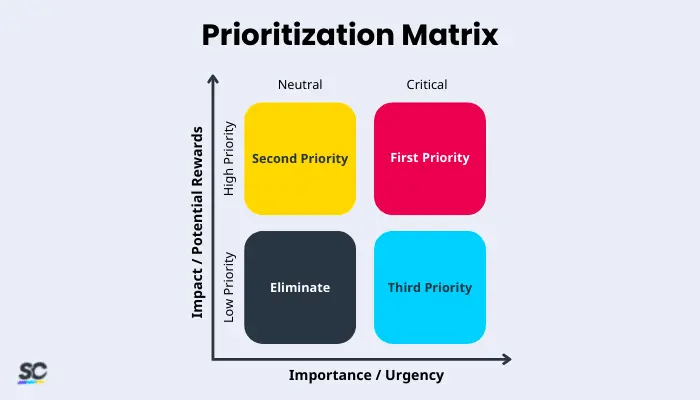What is a Prioritization Matrix?
A prioritization matrix, also called a priority matrix, is a tool that can help you prioritize tasks, goals, or anything else based on two factors—importance and urgency. By determining how important and urgent something is, you can quickly prioritize what you need to do and ensure that you’re always working on the most important tasks.
The prioritization matrix is essentially a grid with four quadrants. The x-axis is used to assess the importance or urgency of the issue, while the y-axis is used to assess the impact or potential rewards. The quadrants are then used to prioritize the options based on their urgency and importance.

This matrix is one of the many management tools used in the Six Sigma methodology. The beauty of the matrix is that it forces you to weigh the importance and urgency of each option against each other. This can help you quickly identify which options are the most important or urgent and which ones can be put on the back burner.
Prioritization matrices are easy to use and can be extremely helpful in both your personal and professional life. If you’re looking for a helpful tool to help you assess and prioritize your projects, objectives, or goals may be the perfect solution.
What Does it Do?
A prioritization matrix is a tool that helps you prioritize the initiatives and projects that your company is working on. It allows you to compare and contrast different projects in terms of their importance and impact on the business. This tool is particularly useful when you have a lot of initiatives underway and need to figure out which ones to focus on first.
The matrix can be customized to your company’s specific needs and typically includes factors such as the expected return on investment (ROI), the timeframe, the risks, and the impact. By evaluating each project against these factors, you can get a better sense of which ones are the most important and should be given the most attention.
Benefits of Using One
Using a prioritization matrix provides many benefits, such as the following:
- Helps in breaking down and prioritizing complex issues, especially when various factors affect decision-making
- Allows you to easily categorize and rank your priorities
- Identifies the most important areas that need to be focused on
- Creates a fundamental explanation about what important things are to be discussed
- Assembles a team that supports essential buy-ins
When Should You Use It?
So, when can you use a prioritization matrix? You can use it when:
- Needing help in prioritizing projects that you find complicated to do
- Ensuring better time management for your task
- Enhancing and improving harmony for your daily task
What are the 4 Levels of Prioritizing Tasks?
There are four levels or categories in prioritizing tasks. Handling each level can vary from person to person and from company to company. Let’s discuss each one of them:
- Critical – These tasks are often considered urgent and time-sensitive, wherein teams are required to stop whatever they are doing and immediately do them. When a critical task is not immediately attended to, it can create various risks for a business.
- High priority – High priority tasks are quite similar to critical tasks but are not time-sensitive. They can be done in a week or so hence why it comes second amongst the levels.
- Neutral – This level of task can be patiently done and has no immediate deadline.
- Low priority – In this level, a task can be done at any given time. If there is any deadline, it can be moved or changed anytime without any problem.
How to Prioritize Tasks with a Prioritization Matrix?
There are many different ways to prepare a prioritization matrix, but the basic idea is to list out all of your options and then rate them on a scale of importance. This can be done using a simple table or spreadsheet, or you can use a more sophisticated tool like a Kanban board or a digital platform.
Here are some tips to help you prepare one:
List Down All Your Tasks
Begin by listing down all the tasks you need to do, whether big or small and urgent or not. This will help you analyze and organize all the tasks at hand.
Identify Each Task’s Criteria and Weight
One way to determine and measure criteria for the task is by comparing the input (amount of time and effort needed to complete a task) against the output (completed project). Gauging the input against its output will provide you with its position in the matrix.
Determine Its Urgency
Now that you’ve established the criteria, it’s time to decide how urgent each will be. Using the rows and columns, you can easily determine which tasks fit in the matrix.
Analyze the Completed Matrix
Finally, it’s time to review what you have prepared and created to see if it’s correct. Always keep in mind that the tasks inside the top-right quadrant should be the most essential on the list.
Create Your Own Prioritization Matrix Template
Eliminate manual tasks and streamline your operations.
Get started for FREEHow to Use a Prioritization Matrix
A prioritization matrix can be used across different industries and help organizations organize their tasks more efficiently. Below are some steps to help you use a prioritization matrix to evaluate projects easily.
Step 1: Select A Task or Project
Choose which task or project based on the urgency inside the matrix. This is because using priority matrices can help you decide what you need to do according to their ranking.
Step 2: Establish Your Criteria
Next, you need to identify criteria that will be used to prioritize the objectives. These criteria can be things like impact, urgency, difficulty, etc. Once again, you can brainstorm or write down a list of criteria.
Step 3: Rate Objectives and Criteria
After you have defined the objectives and criteria, it’s time to rate them. For each objective, you should score how well it meets each criterion on a scale from 1 to 10 (with 1 being the lowest and 10 being the highest).
You can also use a different scale if you prefer (e.g., 1 to 5 or 1 to 100). Just make sure that you are consistent with the system that you use.
Step 4: Set Your Priorities
The next step is to determine priorities. This is because some projects may be more important than others. By setting your priorities, you will be able to work on the most important task first and then move on to the next one.
Step 5: Provide a Reviewable Resource
Make sure to store your priority matrices for later use. This will be your reference or guide when you want to do them again. It will be useful in providing output or the outcome of what you did when completing the task.
Whichever method you choose, the benefits of using a prioritization matrix are clear. By taking the time to prioritize your tasks, you can save yourself a lot of time and effort in the long run. You’ll be able to work on the most important tasks first and do the rest in your spare time.
Prioritization Matrix Example
To give you a visual representation of how the prioritization matrix is used, here’s an example of which project a marketing team should focus on in their coming fiscal year.
The criteria for this matrix are as follows:
Criteria for urgency:
- 1 point: not urgent at all
- 2 points: not very urgent
- 3 points: somewhat urgent
- 4 points: kind of urgent
- 5 points: very urgent, required ASAP
Criteria for impact:
- 1 point: very low to no impact
- 2 points: low impact
- 3 points: medium impact
- 4 points: high impact
- 5 points: very high impact
| Task | Impact | Urgency | Total score |
| Launch a new product | 5 | 4 | 9 |
| Develop a marketing campaign | 4 | 3 | 7 |
| Improve customer support | 3 | 5 | 8 |
| Upgrade the company website | 3 | 4 | 7 |
| Reduce operating costs | 3 | 1 | 4 |
Compute the total score for each to calculate the priority level. Priority levels are sorted as follows:
8–10 points: High priority
5–7 points: Medium priority
1–4 points: Low priority
In this example, our prioritization matrix has revealed that launching a new product and improving customer support should be the top priorities for the team. Next to those are the tasks of developing a new marketing campaign and upgrading the company’s website. On the other hand, reducing operating costs appears to be a lower-priority task, as it does not demand immediate attention from the company.
Achieve operational excellence
Cultivate a culture of excellence with our digital solutions that enhance efficiency, agility, and continuous improvement across all operations.
Explore nowFAQs About Prioritization Matrix
A prioritization matrix is a technique that is very helpful in identifying what problems require immediate action or solution.
A priority matrix provides a simple method to sort out a diverse set of tasks or projects and rank them accordingly depending on their criteria of importance.
A 2×2 prioritization matrix, also known as the lean prioritization approach, is a tool that guides and assists teams by helping them decide what to discuss for their next product backlog.
A prioritization matrix can be used for prioritizing causes or solutions in a Six Sigma project.



